
Features
Structures & Equipment
Water and irrigation
The Dose Size Factor
July 18, 2011 By Arie Alblas
The term “Dose Size Factor” (DSF) offers growers a tool to optimize the
watering frequency and irrigation size for cultivation on stonewool. A
recently completed multi-year study at the Improvement Centre in
Bleiswijk, the Netherlands, concluded that a dose size factor of 25 is
optimum to guarantee maximum rooting and a homogeneous water
distribution and EC.
The term “Dose Size Factor” (DSF) offers growers a tool to optimize the watering frequency and irrigation size for cultivation on stonewool. A recently completed multi-year study at the Improvement Centre in Bleiswijk, the Netherlands, concluded that a dose size factor of 25 is optimum to guarantee maximum rooting and a homogeneous water distribution and EC.
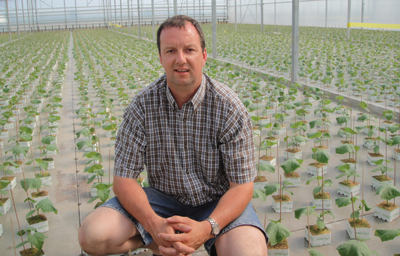 |
| Envirotex product manager Arie Alblas. Advertisement
|
The DSF is a figure that represents the relationship between the volume of water per dripper and the volume that the dripper has to refresh (in litres). It is a measurement of the amount of irrigation water (in cc) during one irrigation cycle per dripper per litre substrate.
A DSF factor of 25 is equivalent to 25 cc per dripper per litre substrate. Based on multi-year research at the Improvement Centre, stonewool supplier Saint-Gobain Cultilene demonstrated that a DSF of 25 is optimum. At this level you get a wide and high cone. (Fig. 1) This is necessary for a homogeneous water distribution in the slab, in particular the horizontal and vertical distribution of water and a uniform EC. Both factors have a major influence on the rooting in the slab and thus the ability of plants to absorb water and nutrients. By using optimum DSF and a correct composition of the irrigation water, the development of the crop, in principle, will never be inhibited by these cultivation factors.
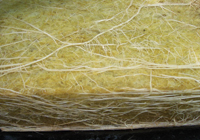 |
|
| Optimum rooting throughout slab with DSF of 25. |
WATER DISTRIBUTION THROUGHOUT THE SLAB
■ Research at the Improvement Centre confirms the earlier results of research by Cultilene. With a larger DSF (more than 30), you would give more water per irrigation cycle, but this water drops to the bottom of the slab. On average, with a DSF of over 30, the irrigation amount is the same, yet the water is less evenly distributed throughout the slab and less evenly absorbed in the slab. The longer breaks between irrigation cycles create lower water content in the top layer of the slab seen most clearly between drippers.
A too small DSF (less than 20) should be avoided as well. The irrigation cycles are following in high frequencies but the water cone is small and not sufficient to wet the sides of the slab, and will result in lower water content.
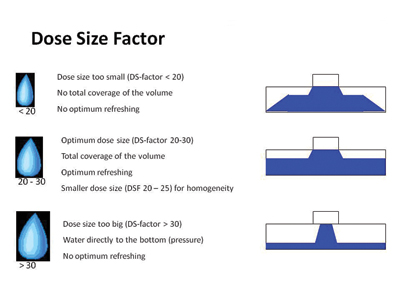 |
| Fig. 1: Water management in the slab, with different DSF.
|
IRRIGATION ACCUMULATION
■ With a DSF of 25, just as with a larger DSF, the slab is moistened over the entire length and width. The difference is that the top layer will not suffer from inadequate water content. With frequent irrigation cycles, the water is repeatedly spread over the moist slab. This creates structurally higher water content in the top of the slab than if a large DSF would be used.
CONTROL PHASE
■ In the first phase of vegetable crops, growers often give very little or no water for generative plant development. This can cause problems with re-saturation and refreshment in the middle of the slab causing poor root development, resulting in a lower yield.
The water content decreases uniformly during this control phase over the length of the slab. Prolonged water restriction periods dry the top layer of the slab. Because the plant consumes more water than nutrients, the EC will rise sharply.
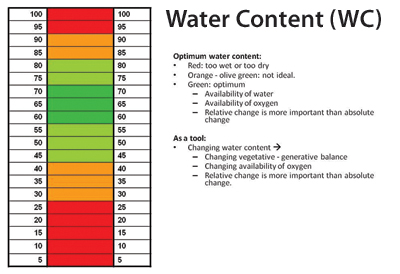 |
| Optimum water content reference chart. |
Around the block and at the bottom of the slab, the EC increases more than in the middle of the slab, resulting in greater differences in water content and EC. When irrigation is resumed after the control phase, the water content around the block can easily rise and the EC drops accordingly. In the middle of the slab, the top and middle layers are refreshed at a lower rate. Differences in water content and EC will still exist.
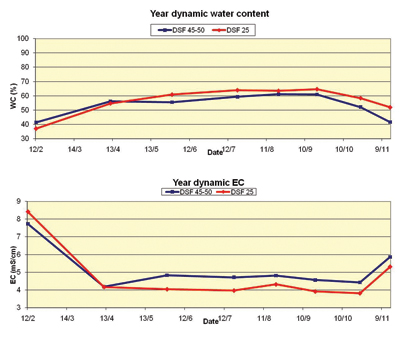 |
| Dynamics in water content and EC during the cultivation of various dose size factors.
|
STANDARD DEVIATION
■ Growers seek a uniform crop development and therefore prefer to grow on slabs that are homogeneous. Factors
affecting variations between slabs are profile differences, differences between the drippers, the drainage slits and their location, and cleanliness of water lines and drippers.
There can also be variations within slabs. Possible causes for this include a long control phase, great distances between drippers, saturation of the slab with a high EC, and the particular substrate characteristics.
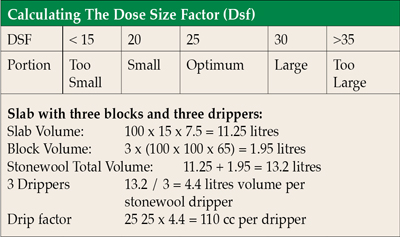
|
SUBSTRATE UTILIZATION VOLUME
■ The practical implementation of the research shows that growers with a DSF of 25 make maximum use of the available substrate volume and have the lowest possible chance of growth differences due to variations in water content and EC. With a DSF of 25, the EC is 0.8 mS/cm lower on average measured over the whole crop and there are much less significant differences in the EC within the slabs. The water content or refreshment rate of the slab with a DSF of 25 is, on average, nine per cent higher.
What makes the DSF, as a rule of thumb, very helpful, is its independence from the absolute amount of water applied per 24-hour period. With DSF 25 as a starting point, growers are never far from the optimum.
Arie Alblas is product manager with Envirotex. • www.envirotex.ca, arie@envirotex.ca
Print this page